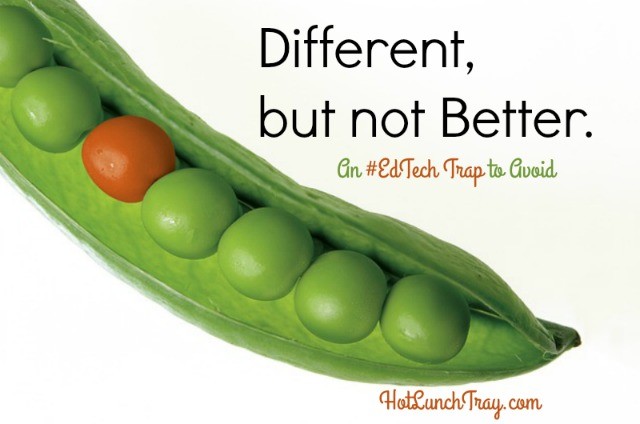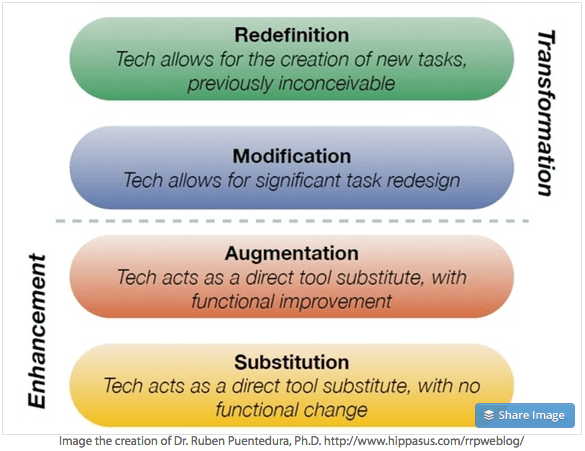Educators are the nicest people you will ever meet. That makes it extra tough, but at some point “trying #edtech” is not enough. By only trying educational technology educators are not investing enough in the power of the technology and are only doing their lessons different, but not better. It is a mistake to let this happen as the power of the technology is not only hidden, but might be dismissed entirely.
In my Curation of Content post, I talked about falling into this trap. I promoted something which was different and not better. That practice undermines credibility and the potential of technology.

SAMR Ladder per Lesson
The SAMR model identifies how technologies are used by students in the classroom on a per lesson basis. This model represents different depths which teachers can embed technology into lessons; the first two levels are grouped into Enhancement while the last two levels are grouped into Transformation. The ultimate goal of SAMR is to transform learning experiences to result in higher levels of student achievement. {how to use technology in classrooms}
Teachers who target higher-order cognitive skills while they introduce select {Type II} technologies as tools in lessons promote Transformational lessons. Lessons which combine the two factors are likely to have a significant impact on student outcomes (SAMR).
Never pressure a teacher to always teach “above the line,” it would exhaust them to try and is not necessary.
Who is Speaking Please?
Any #EdTech position (Instructional Technologist, eLearning, ICT) likely has primary training in education over technology. Typically technology is a passion tapped-into, but not one for which teachers receive formal training. So, an #EdTech specialist has an educator’s opinion and naturally s/he also has a technologist’s opinion. It is important to identify from which position you speak.
Reserve your educational opinion, but gently challenge the teacher to identify the educational objective and then suggest tools from the technologist’s point of view which can climb as high up the SAMR ladder as possible.
{Refer to Type I & Type II Technologies post}
Stop calling this #EdTech
At some point, educational leaders need to stop calling any use of educational technology “integration.” Leaders would be better advised to use specific terms from the SAMR model. Pure substitution does not result in increased student achievement. While augmentation provides improvements, neither substitution nor augmentation are worth the cost of the technology or the opportunity cost for the students. Just integration is not specific enough. Anything less than the Transformative levels do not produce any amplified results for students. But naming the levels of SAMR would show room for, or honor, growth in lesson planning integrating the beneficial levels of technology. The educational leader could better lead teachers toward increased student achievement.
Avoid the #EdTech trap of promoting different, but not better.






2016-11-28 at 12:19 pm
SAMR seems like a handy model. Like with many models, they all grasp more less the same phenomena, but in different ways. SAMR is exceptionally simple, so it might be handy.
Do you use it a lot? Would you like to offer a case study – or provide a link to one – showing the transition from the basic level up to Redefinition stage?
2016-11-28 at 12:41 pm
Nikos,
I am interested in that myself. I took the New Horizon Media’s self-paced course on SAMR: Redefining e-Learning https://www.nmc.org/courses/samr-redefine-elearning-keep-focus-on-learning-tasks-not-tools/ . I liked their content, but felt the audience was the already converted.
Let’s both keep our eyes open for something like that … we cannot be the only ones interested!
2016-11-30 at 6:51 am
O, thanks for the info!
So far I several articles down, if you find – or I’ll find – some extensive read, good thorough article, it’s good to show it to the people!
I think this way of thinking not necessarily is new, but still rooted in cognitive psychology thinking, cognitive developmental, like started by Jean Piaget some time ago, when understanding happens when deep redefinition happens.
ALSO, Redefinition has been a trendy term for some time, but it’s – as far as I’m concerned – tough to be measured, when it happens and how to actually lead to it.
Maybe in part since it depends largely on what cognitive structures the learner already has (knowledge, skills, understanding level, personal experiences and so on).